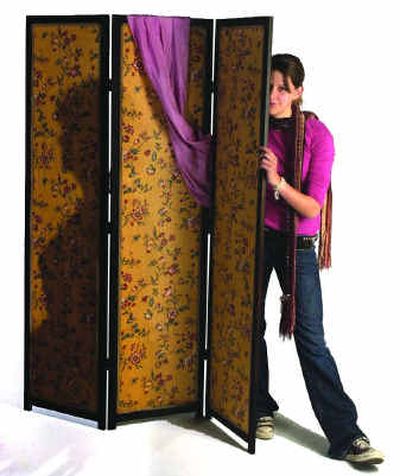Create a piece of functional furniture by giving new life to a classic folding screen

S
ometimes four walls just aren’t enough. Occasionally a room needs a portable line of demarcation, something to divide spaces, or hide an area from view. For centuries, folding screens have served that purpose.
In medieval time, screens blocked doorways and gave shelter from the cold air that rushed in.
Before indoor plumbing, they were used to hide the chamber pot and provide privacy while bathing and dressing.
William Morris, the iconic 20th century craftsman and designer whose philosophy was that we should have nothing in our homes that is not useful or beautiful, produced elaborate screens with embroidered or stained glass panels.
Today, screens are still decorative and functional. In urban lofts, living spaces carved out of large commercial buildings, folding screens provide a way to establish intimate places in a larger, more open, space.
In modest suburban homes, folding screens, sometimes called a room divider and usually constructed from hollow core bifold doors or louvered shutters, hide a home office or computer center, or create a cozy nook in the corner of a busy family room.
Folding screen projects make frequent appearances on Home and Garden Television how-to segments, and they are very approachable even for those who don’t consider themselves really “crafty.”
Suzi Gregory, a Spokane area elementary school teacher, purchased a decorative metal screen from Pier One five years ago. The tall screen, made to resemble twigs and leaves and decorated with crystal pendants, has spent time in several rooms since she brought it home.
Gregory didn’t have a specific space in mind when she found the screen. “I bought it thinking that it was a versatile accessory that could be used in a variety of settings,” Gregory says.
In its latest incarnation, the screen served as a headboard in her guest room.
Charlotte Rodgers-Roe, owner of Interiors by Charlotte, in Post Falls, thinks of folding screens as a versatile accessory.
“I compare them to area rugs,” Rodgers-Roe says. “You can move them around, use them in different rooms and take them with you when you move.”
She notes that they are easy to find at furniture and home interior stores, and they are inexpensive to make. “Go to the home warehouse, buy a set of bi-fold doors and then decorate them any way you want,” she says. “You can make them your own.”
Rodgers-Roe also uses screens as art. “I hang them, like a large painting,” she says. “It gives a lot of impact to a wall.”
She says that the biggest plus to decorating with folding screens is their portability. “A screen is a moveable wall, you can hide – literally screen – an area, or you can divide a space for very little money.”
Interiors by Charlotte is located at 501 E. 12th in Post Falls. For more information call (208) 773-8934
I walked past the battered screen standing in the middle of the thrift store twice before I stopped to take a closer look at it. The wood center panels, carved in an intricate Moroccan pattern, were broken in several places, but the basic frame was intact, the hinges were all there, and it was sturdy.
The $6.99 price tag, and the challenge of making something so ugly beautiful again, persuaded me that the screen might be worth rescuing. So I brought it home.
I decided to cover it with fabric panels, using the wood scrollwork in the center of each section as a backing for the fabric.
First, I cleaned the screen and brushed a light coat of dark brown paint over the exposed frame. Then I hot-glued thin cotton batting (left over from a friend’s quilting projects and free), over the fretwork.
Then, after rummaging through my stash of material, I selected a length of Waverly fabric. The rich gold, one of my favorite colors, would work well with the dark wood. The fabric had been a bargain, $3.50 for more than three yards, because there was a dye irregularity.
I was able to salvage three strips out of the fabric, enough to cover one side of the screen, by cutting around the flawed portion.
I stapled the fabric, stretched over the batting, to the wood frame of the screen, then hot-glued bias tape (less than $7 for 24 yards) to cover the edges of the fabric. I’ll cover the back of the screen with another fabric, for two different looks
I finished the corners with brass upholstery tacks. The total cost for the project was less than $20.
Suddenly, the ratty wood screen that no one would help me unload out of the car was a must-have accessory. My daughter says she is willing to take it off my hands and let it stand in the corner of her room.
Lucky me.